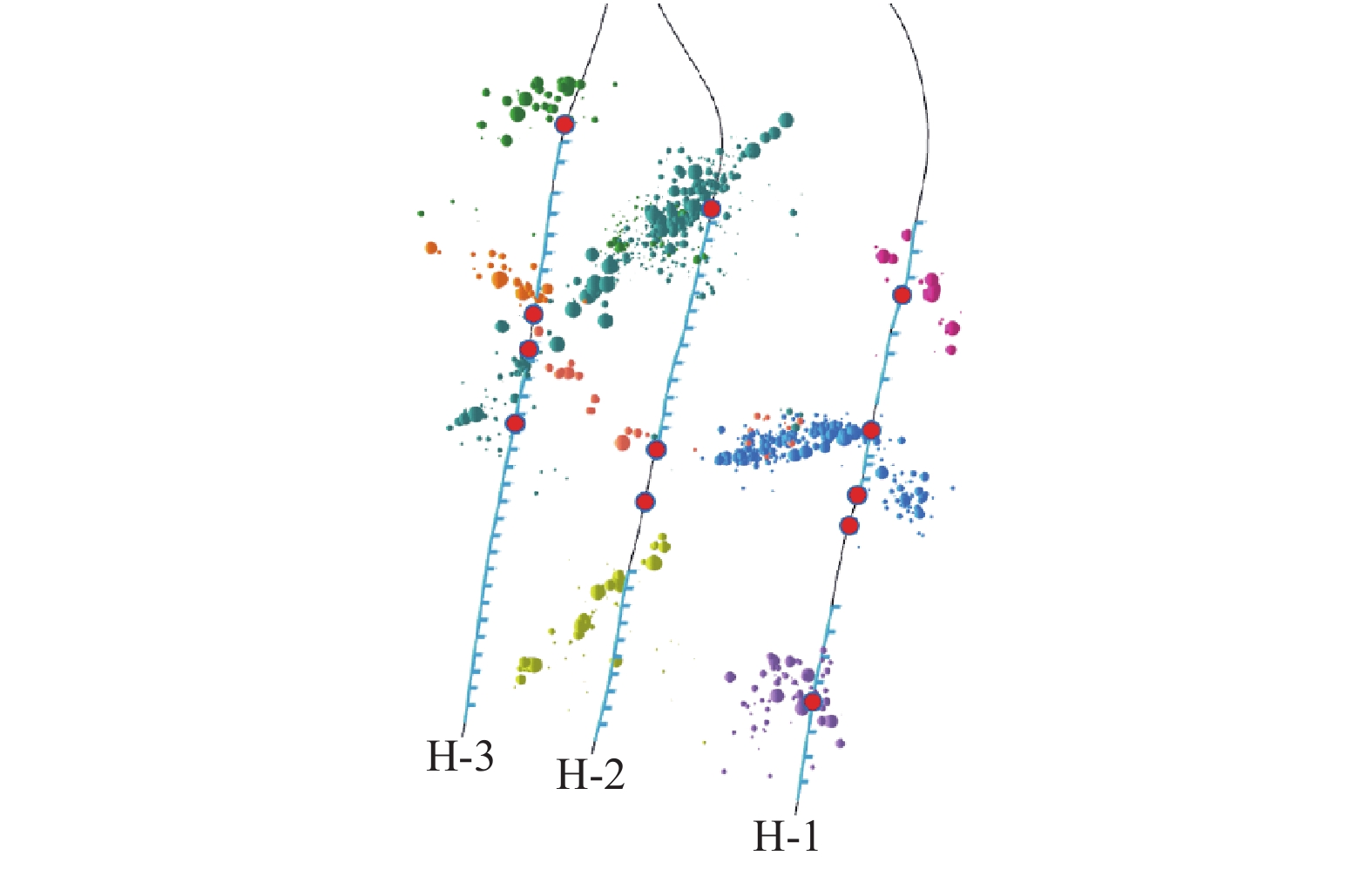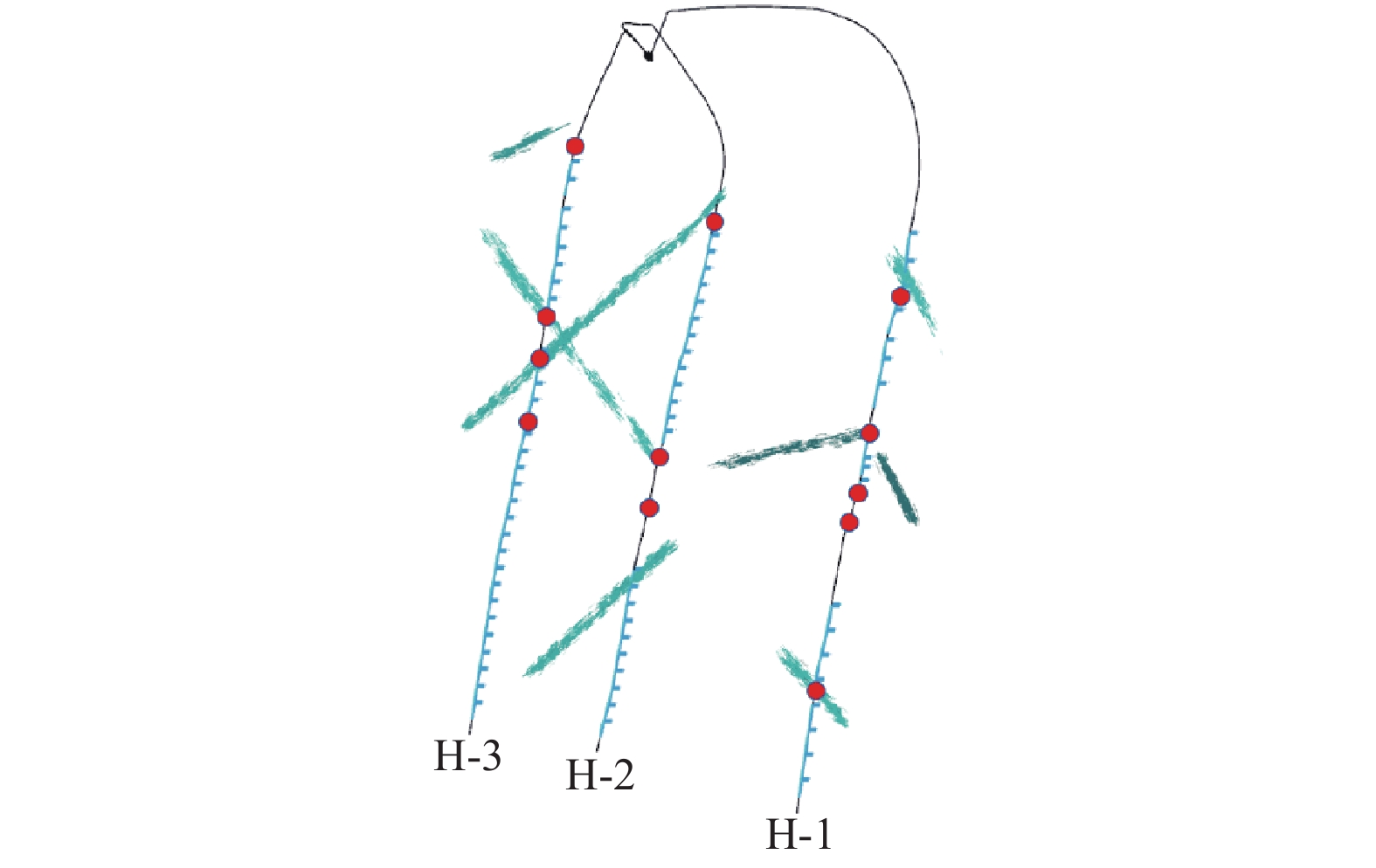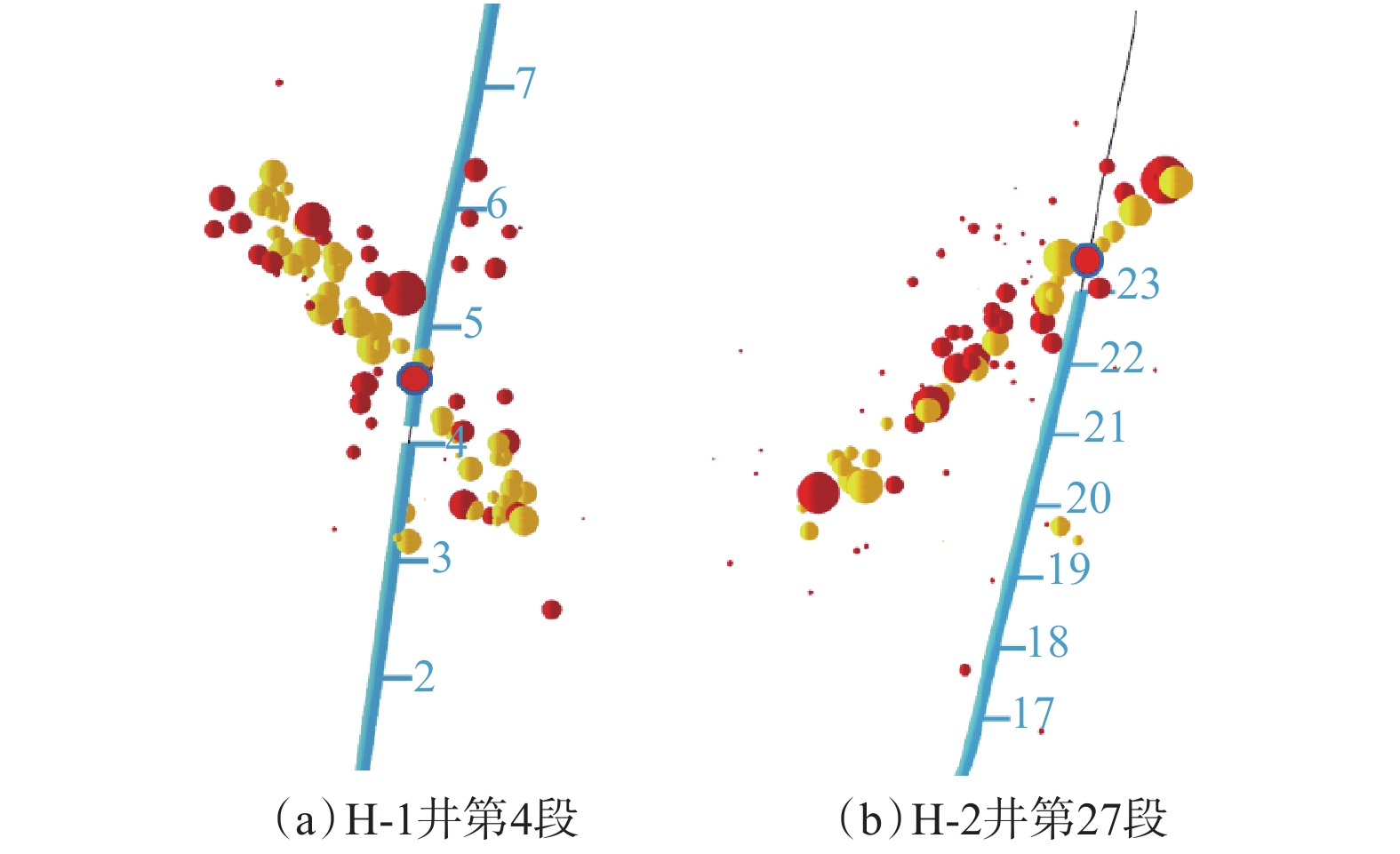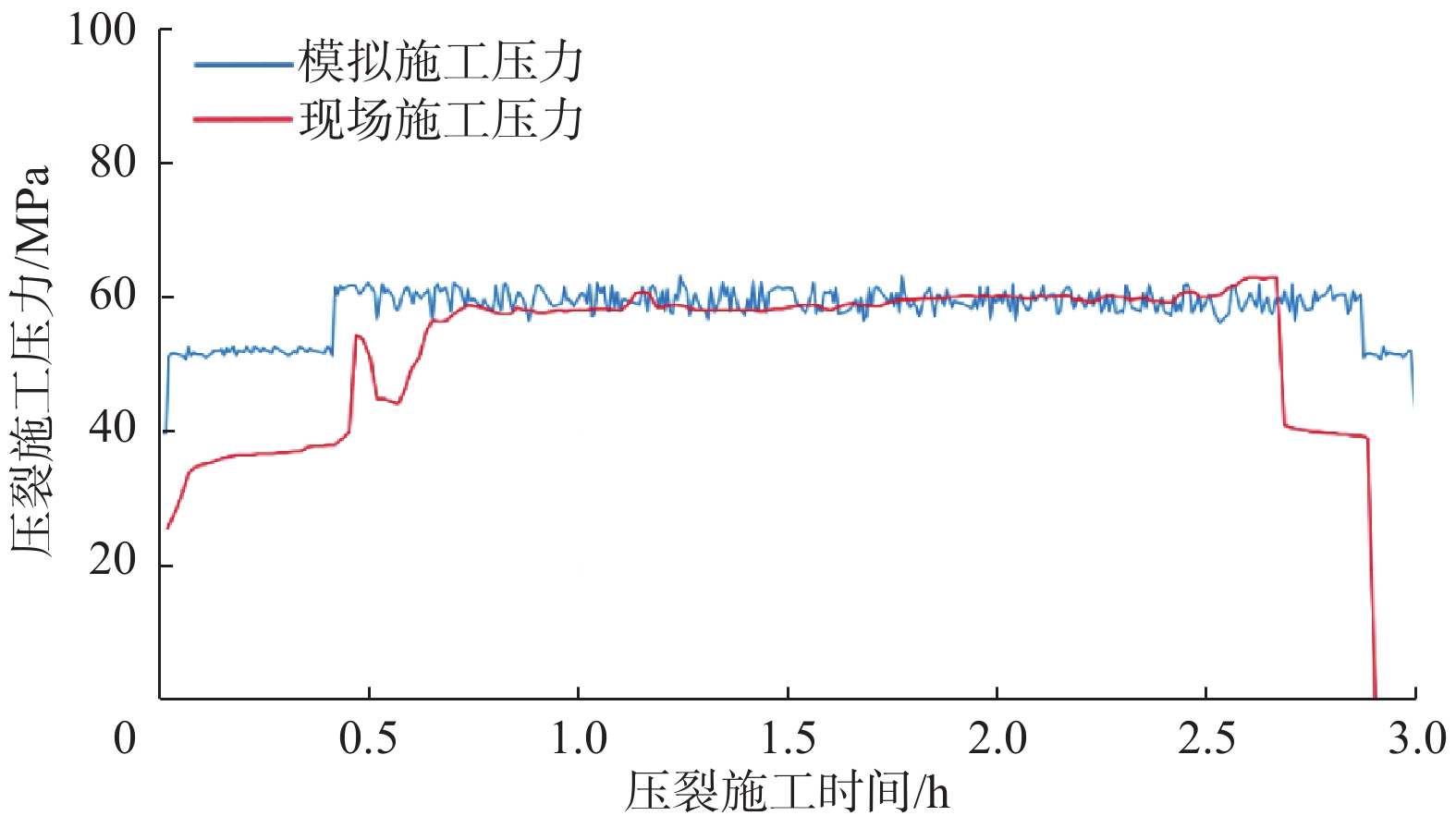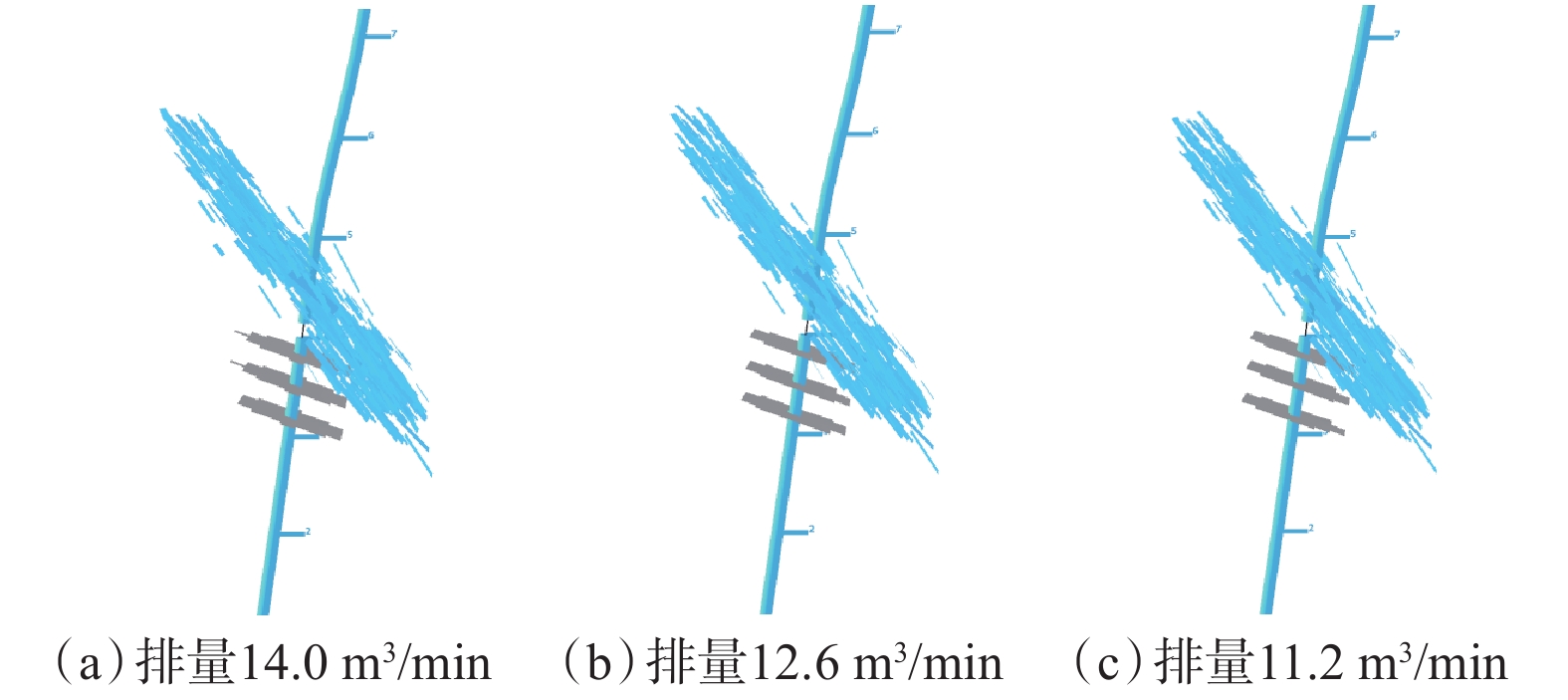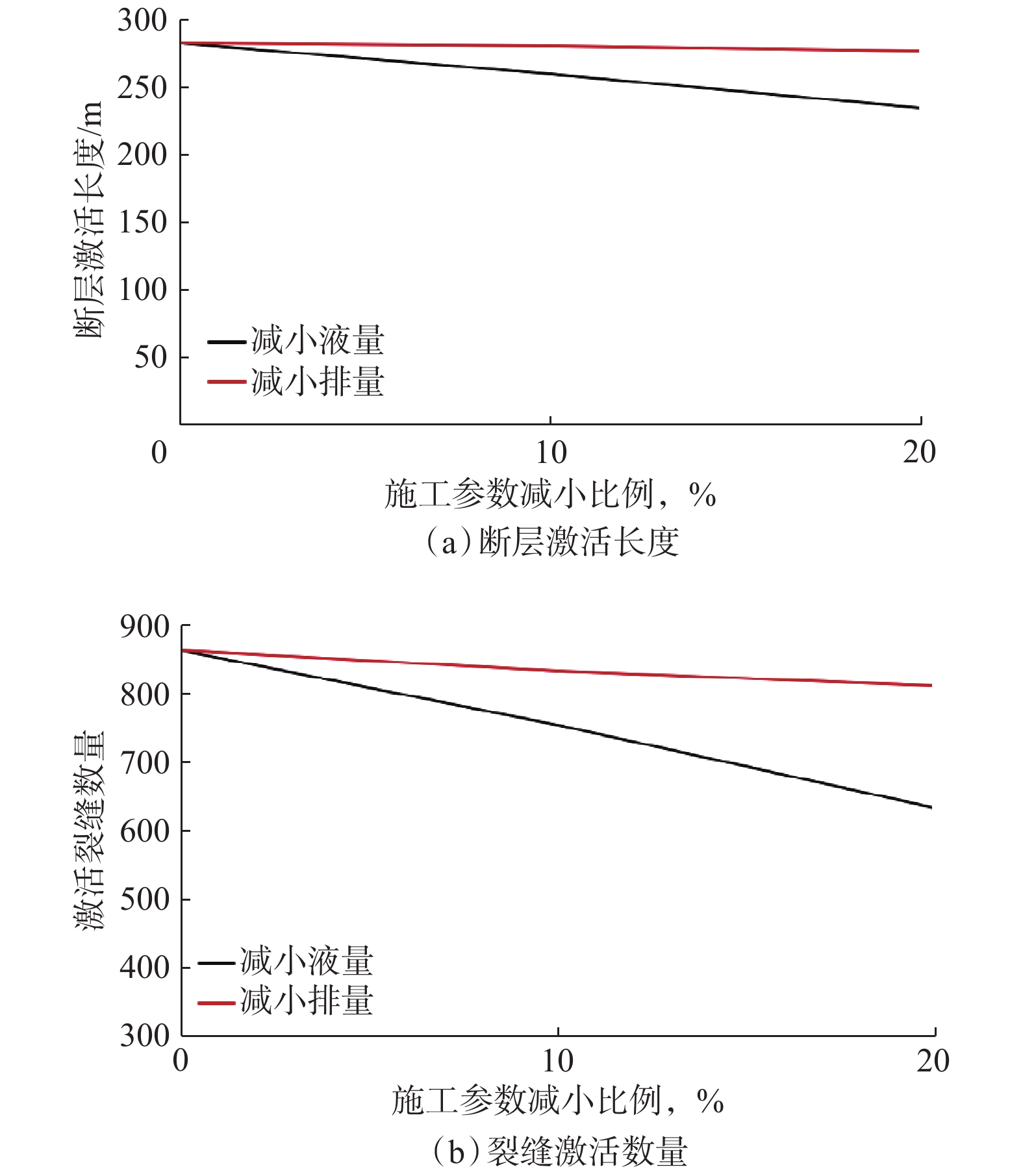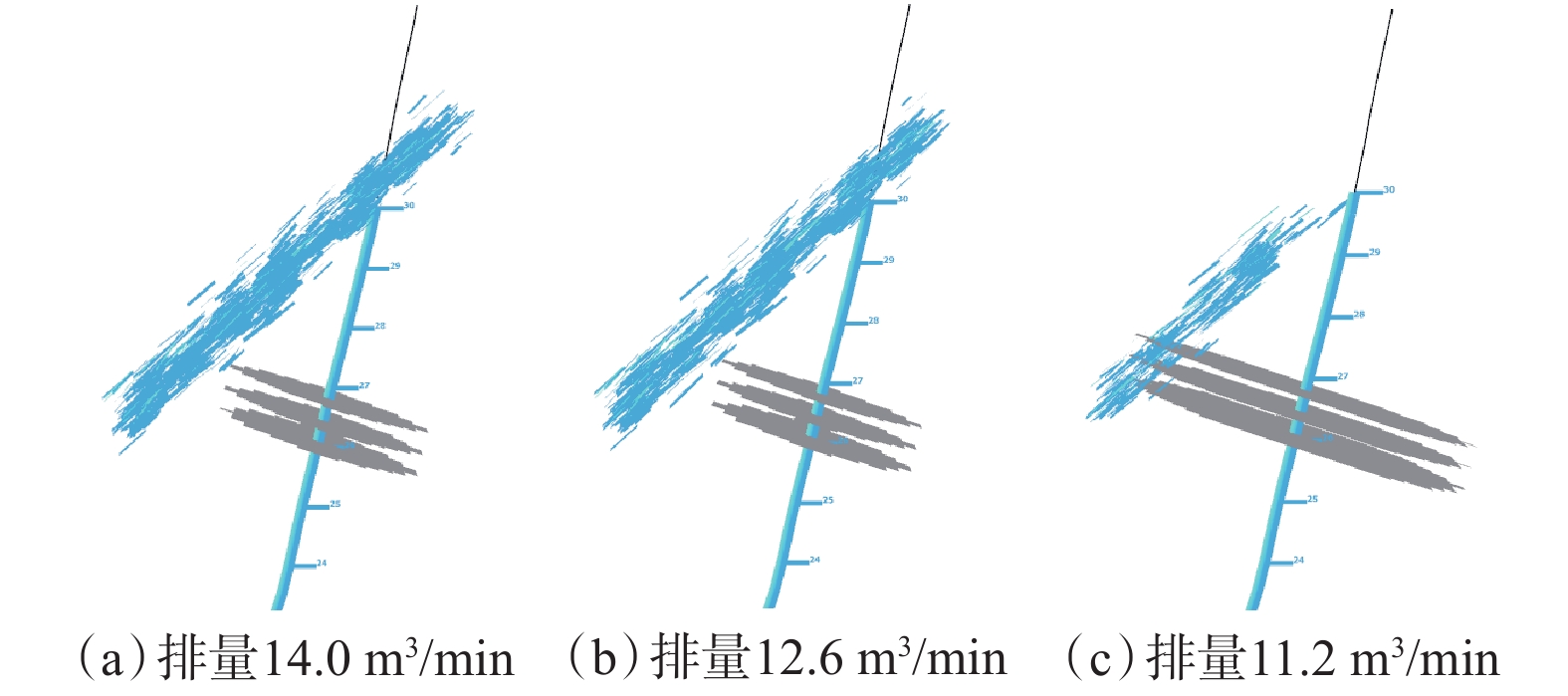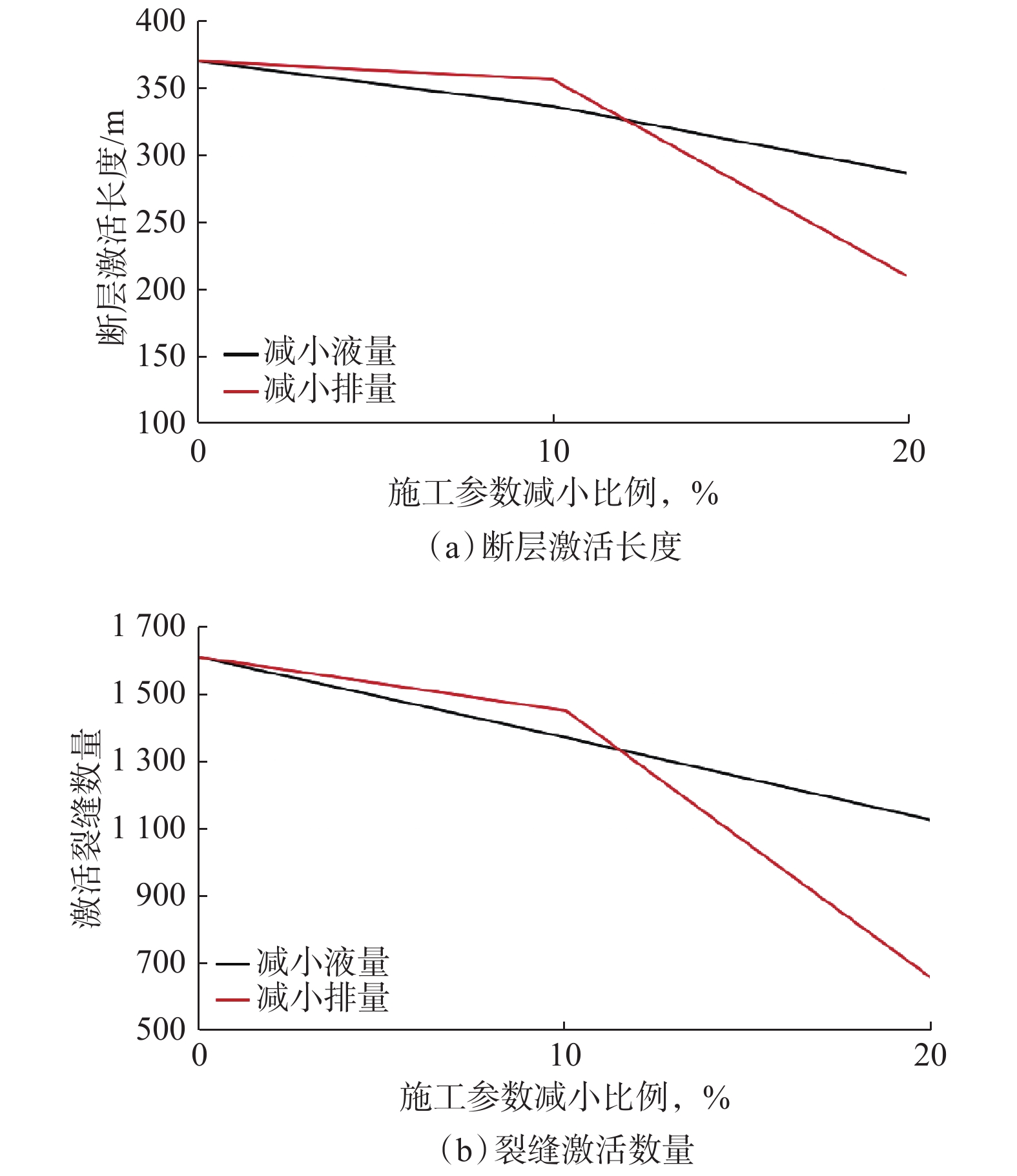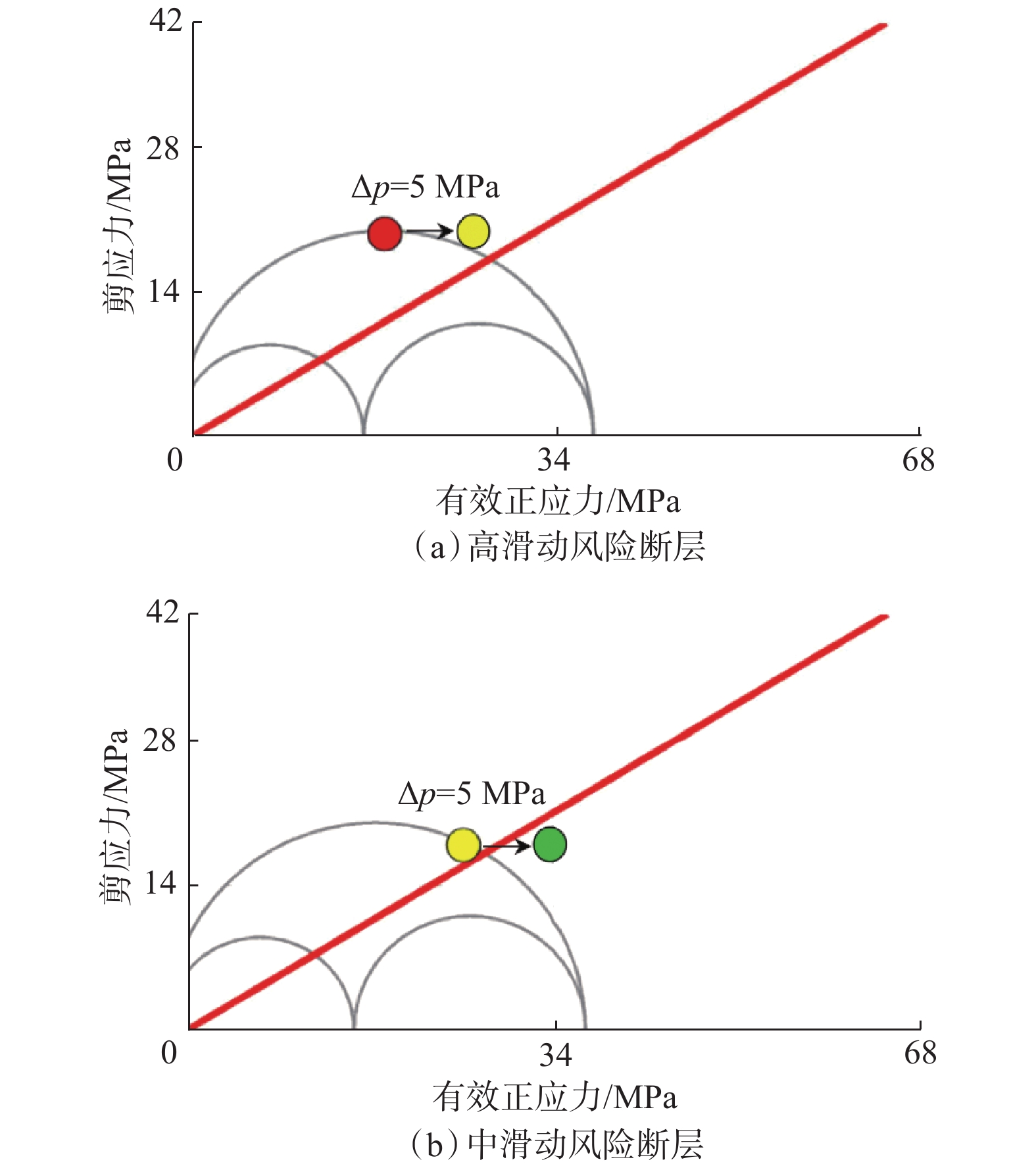Analysis and Optimization of Construction Parameters for Preventing Casing Deformation in the Changning Shale Gas Block, Sichuan Basin
-
摘要: 为解决四川盆地长宁页岩气区块的套管变形问题,进行了套管变形井施工参数优化分析。基于统计数据,对该区块施工参数优化现状进行了分析;基于三维地震、测井资料及测试数据,建立了该区块H平台裂缝和地应力模型;基于摩尔–库仑临界应力和物质守恒准则,进行了水力压裂数值模拟;根据滑动风险的分类,分析了压裂施工参数和裂缝带激活的关系。由统计分析可知:只采取减液量措施,裂缝带套管变形比例为21.7%;只采取减排量措施,裂缝带套管变形比例为8.1%。通过压裂模拟可知:对于高滑动风险断层,当液量减小20%时,断层激活长度和裂缝激活数分别减小17%和26%,当排量减小20%时,断层激活长度和裂缝激活数分别减小3%和6%;对于中滑动风险断层,当液量减小20%时,断层激活长度和裂缝激活数分别减小22%和30%,当排量减小20%时,断层激活长度和裂缝激活数分别减小43%和60%。研究结果表明,“高滑动风险断层减液量,中滑动风险断层减排量”的压裂施工参数优化建议,可供现场解决套管变形问题时参考。Abstract: In order to solve the problem of casing deformation in the Changning shale gas block in the Sichuan Basin, the construction parameters of wells with deformed casing were analyzed and optimized. The fracture and in-situ stress model of the platform H were established based on 3D seismic data, logging and test data. The hydraulic fracturing numerical simulation was conducted based on the Mohr-Coulomb critical stress and mass conservation law. Based on the classification of slip risk, the relationship between the construction parameters for fracturing and activation of fracture zones was analyzed. The statistics and analysis results showed that when only fluid volume reduction measures were taken, the casing deformation ratio in fractured zones was 21.7%. When only the flowrate reduction measures were taken, the casing deformation ratio was 8.1%. It can been seen from fracturing simulation that, for those faults with high slip risk, when the fluid volume is reduced by 20%, the length of activated fault and the number of activated fractures are decreased by 17% and 26%, respectively. When the flowrate is reduced by 20%, the length of activated fault and the number of activated fractures are reduced by 3% and 6%, respectively. For those faults with medium slip risk, when the fluid volume is reduced by 20%, the length of activated fault and the number of activated fractures are decreased by 22% and 30% respectively. When the flowrate is reduced by 20%, the length of activated fault and the number of activated fractures are decreased by 43% and 60%, respectively. The research results showed a suggestion on construction parameters that reducing fluid volume for high slip risk faults and reducing flowrate for medium slip risk faults. This could provide a reference for solving casing deformation problem on site.
-
-
-
[1] 陈朝伟,石林,项德贵. 长宁—威远页岩气示范区套管变形机理及对策[J]. 天然气工业,2016,36(11):70–75. doi: 10.3787/j.issn.1000-0976.2016.11.009 CHEN Zhaowei, SHI Lin, XIANG Degui. Mechanism of casing deformation in the Changning-Weiyuan national shale gas project demonstration area and countermeasures[J]. Natural Gas Industry, 2016, 36(11): 70–75. doi: 10.3787/j.issn.1000-0976.2016.11.009
[2] 陈朝伟,项德贵,张丰收,等. 四川长宁—威远区块水力压裂引起的断层滑移和套管变形机理及防控策略[J]. 石油科学通报,2019,4(4):364–377. CHEN Zhaowei, XIANG Degui, ZHANG Fengshou, et al. Fault slip and casing deformation caused by hydraulic fracturing in Changning- Weiyuan Blocks, Sichuan: mechanism and prevention strategy[J]. Petroleum Science Bulletin, 2019, 4(4): 364–377.
[3] DONG Kai, LIU Naizhen, CHEN Zhaowei, et al. Geomechanical analysis on casing deformation in Longmaxi shale formation[J]. Journal of Petroleum Science and Engineering, 2019, 177: 724–733. doi: 10.1016/j.petrol.2019.02.068
[4] YIN Fei, HAN Lihong, YANG Shangyu, et al. Casing deformation from fracture slip in hydraulic fracturing[J]. Journal of Petroleum Science and Engineering, 2018, 166: 235–241. doi: 10.1016/j.petrol.2018.03.010
[5] ZHANG Fengshou, YIN Zirui, CHEN Zhaowei, et al. Fault reactivation and induced seismicity during multistage hydraulic fracturing: microseismic analysis and geomechanical modeling[J]. SPE Journal, 2020, 25(2): 692–711. doi: 10.2118/199883-PA
[6] LIU Kui, TALEGHANI A D, GAO Deli. Semianalytical model for fault slippage resulting from partial pressurization[J]. SPE Journal, 2020, 25(3): 1489–1502. doi: 10.2118/199348-PA
[7] XI Yan, LI Jun, ZHA Chunqing, et al. A new investigation on casing shear deformation during multistage fracturing in shale gas wells based on microseism data and calliper surveys[J]. Journal of Petroleum Science and Engineering, 2019, 180: 1034–1045. doi: 10.1016/j.petrol.2019.05.079
[8] MAXWELL S. Microseismic imaging of hydraulic fracturing: improved engineering of unconventional shale reservoirs[M]. Society of Exploration Geophysicists, 2014.
[9] CLADOUHOS T T, MARRETT R. Are fault growth and linkage models consistent with power-law distributions of fault lengths[J]. Journal of Structural Geology, 1996, 18(2/3): 281–293.
[10] YAGHOUBI A. Hydraulic fracturing modeling using a discrete fracture network in the Barnett Shale. International[J]. International Journal of Rock Mechanics and Mining Sciences, 2019, 119: 98–108. doi: 10.1016/j.ijrmms.2019.01.015
[11] 陈朝伟,王鹏飞,项德贵. 基于震源机制关系的长宁—威远区块套管变形分析[J]. 石油钻探技术,2017,45(4):110–114. CHEN Zhaowei, WANG Pengfei, XIANG Degui. Analysis of casing deformation in the Changning-Weiyuan Block based on focal mechanism[J]. Petroleum Drilling Techniques, 2017, 45(4): 110–114.
[12] 郎晓玲,郭召杰. 基于DFN离散裂缝网络模型的裂缝性储层建模方法[J]. 北京大学学报(自然科学版),2013,49(6):964–972. LANG Xiaoling, GUO Zhaojie. Fractured reservoir modeling method based on discrete fracture network model[J]. Acta Scientiarum Naturalium Universitatis Pekinensis, 2013, 49(6): 964–972.
[13] COTTRELL M G, HARTLEY L J, LIBBY S. Advances in hydromechanical coupling for complex hydraulically fractured unconventional reservoirs[R]. ARMA-2019-0504, 2019.
[14] ODA M, YAMABE T, ISHIZUKA Y, et al. Elastic stress and strain in jointed rock masses by means of crack tensor analysis[J]. Rock Mechanics and Mining Sciences, 1993, 30(6): 89–112.
[15] COTTRELL M, HOSSEINPOUR H, DERSHOWITZ W. Rapid discrete fracture analysis of hydraulic fracture development in naturally fractured reservoirs[R]. SPE 1582243, 2013.
[16] ROGERS S, ELMO D, DUNPHY R, et al. Understanding hydraulic fracture geometry and interactions in the Horn River Basin through DFN and numerical modeling[R].SPE 137488, 2010.
[17] 马克 D 佐白科.储层地质力学[M].石林, 陈朝伟, 刘玉石, 等, 译.北京: 石油工业出版社, 2011: 90−92. ZOBACK M D. Reservior geomechanics[M]. Translated by SHI Lin, CHEN Zhaowei, LIU Yushi, et al. Beijing: Petroleum Industry Press, 2011: 90−92.
[18] WALSH F R, ZOBACK M D. Probabilistic assessment of potential fault slip related to injection-induced earthquakes: application to north-central Oklahoma, USA[J]. Geology, 2016, 44(12): 991–994. doi: 10.1130/G38275.1
[19] CHEN Zhaowei, FAN Yu, HUANG Rui, et al. Case study: fault slip induced by hydraulic fracturing and risk assessment of casing deformation in the Sichuan Basin [R]. URTEC-198212-MS, 2019.
[20] CHEN Zhaowei, ZHOU Lang, WALSH R, et al. Case study: casing deformation caused by hydraulic fracturing-induced fault slip in the Sichuan Basin[R]. URTEC-2882313-MS, 2018.
-
期刊类型引用(17)
1. 陈小璐,张雨菲,罗伟疆,蔡卓林,鱼文军. 水平井体积压裂套管变形预测方法与防控措施. 新疆石油天然气. 2025(01): 61-68 .  百度学术
百度学术
2. 尹奥博,李军,连威,张辉. 页岩气水平井套管变形机理及控制方法研究进展. 新疆石油天然气. 2025(01): 50-60 .  百度学术
百度学术
3. 闫炎,蔡萌,马文海,张晓川,韩礼红,刘永红. 盐岩蠕变特征对井筒形变量的影响规律. 西安石油大学学报(自然科学版). 2024(03): 42-49 .  百度学术
百度学术
4. 赵晋斌,张竣淞,程志恒,赵渝龙,刘洪汰,季长江. 基于微破裂能量扫描技术的煤层水力压裂裂缝展布形态研究. 煤炭工程. 2024(S1): 97-103 .  百度学术
百度学术
5. 刘功威,宋光鑫,赵映辉. 水力压裂过程中的页岩气套管螺纹接头刺穿原因分析. 石油管材与仪器. 2023(02): 85-90 .  百度学术
百度学术
6. 李陪,曾波,杨登波,陆应辉,聂靖雯,聂华富. 川南页岩气套管变形井桥塞射孔联作技术. 油气井测试. 2023(03): 37-42 .  百度学术
百度学术
7. 孟胡,吕振虎,王晓东,张辉,申颍浩,葛洪魁. 基于压裂参数优化的套管剪切变形控制研究. 断块油气田. 2023(04): 601-608 .  百度学术
百度学术
8. 张伟,李军,张慧,王典,李托,刘怀亮. 断层滑移对套管剪切变形的影响规律及防控措施. 断块油气田. 2023(05): 734-742 .  百度学术
百度学术
9. 王俊博,田继军,李飞,张轩铭,季东良,王先美,李鑫. 准噶尔盆地南缘煤层气井管柱腐蚀原因及防腐策略. 特种油气藏. 2023(05): 151-157 .  百度学术
百度学术
10. 陈朝伟,周文高,项德贵,谭鹏,宋建,陈晓军,任乐佳,黄浩. 预防页岩气套变的橡胶组合套管研制及其抗剪切性能评价. 天然气工业. 2023(11): 131-136 .  百度学术
百度学术
11. 陈朝伟,项德贵. 四川盆地页岩气开发套管变形一体化防控技术. 中国石油勘探. 2022(01): 135-141 .  百度学术
百度学术
12. 郭大立,唐乙芳,李曙光,张天翔,康芸玮. 基于BP-PSO的致密气压裂施工参数优化. 科学技术与工程. 2022(19): 8304-8312 .  百度学术
百度学术
13. 刘鹏林,李军,席岩,连威,张小军,郭雪利. 页岩断层滑移量计算模型及影响因素研究. 石油机械. 2022(08): 74-80 .  百度学术
百度学术
14. 李晓蓉,刘旭丰,张毅,郭放,王鑫栋,冯永存. 基于分布式光纤声传感的油气井工程监测技术应用与进展. 石油钻采工艺. 2022(03): 309-320 .  百度学术
百度学术
15. 高德利,刘奎,王宴滨,刘金海,李轩. 页岩气井井筒完整性失效力学机理与设计控制技术若干研究进展. 石油学报. 2022(12): 1798-1812 .  百度学术
百度学术
16. 肖勇军,宋毅,陆应辉,蒋佳玉,唐勇,马自强,许嘉乐,聂华富. 川南页岩气套管变形井分簇射孔管串泵送工艺分析. 石油矿场机械. 2021(05): 66-72 .  百度学术
百度学术
17. 张慧,李军,张小军,张鑫,连威. 页岩气井压裂液进入断层的途径及防控措施. 断块油气田. 2021(06): 750-754+760 .  百度学术
百度学术
其他类型引用(15)




 下载:
下载:
